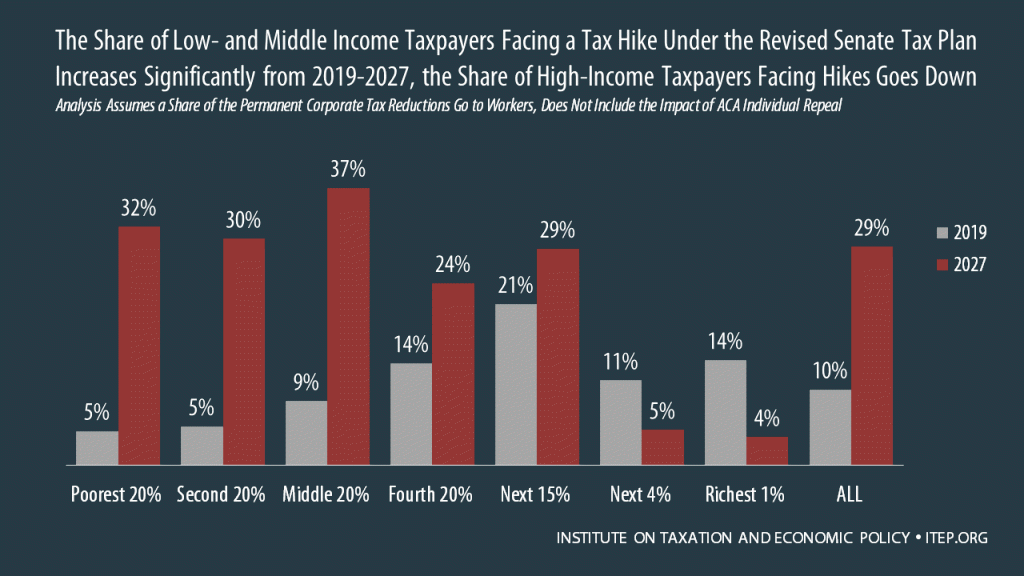A 50-state analysis of the Senate tax proposal finds that not only would greatest share of benefits go to the richest Americans, but also more than one in 10 taxpayers would face a tax hike, with a large number of those taxpayers residing in states where residents pay higher state and local taxes, the Institute on Taxation and Economic Policy (ITEP) said today.
The richest 5 percent of taxpayers collectively would receive more than half of the tax cuts for individuals in 2019, and the top 1 percent would receive a quarter of the cuts. More specifically, the top 1 percent would receive a tax cut worth an average $34,240 in 2019 and $43,300 in 2027.
Nationally, 12 percent of households would face a tax increase in 2019 and 13 percent would face a tax increase in 2027. Additionally, ITEP’s analysis finds that nearly one in three households earning between $112,160 and $239,600 would face a tax hike in 2019, and 16 percent of households earning between $66,850 and $112,160 also would face a tax increase that year.
Taxpayers who face an increase are concentrated in those states with higher state and local taxes, which would no longer be deductible on federal tax returns under the Senate plan.
“Once again we have a tax proposal that purports to help middle-class people but reserves its greatest benefits for the highest-earning households and even raises taxes on some middle-income households,” said Alan Essig, executive director of ITEP. “Lawmakers continue to tout this plan as good for the American people, but they are glossing over the fact that it would balloon the national debt by at least $1.5 trillion and likely force cuts to vital programs and services like education, health care, infrastructure, scientific research, environmental protections, and other priorities. In the end, only the rich and corporations would be net winners.”
Following are some key takeaways from the analysis:
- The rich would get the greatest share of the tax cut as a percentage of income. The bottom 95 percent of taxpayers would see tax cuts that, on average, are equal to 1.1 percent or less of their income while the top 5 percent would receive tax cuts ranging from 1.7 to 2 percent of their income.
- Taxpayers in 10 states are most likely to face a tax increase in part because the Senate plan eliminates the state and local tax deduction. Those states are: Maryland (in which 27 percent of individuals and families would see tax hikes), New Jersey (22 percent), Connecticut (22 percent), California (20 percent), New York (19 percent), Georgia (19 percent), Virginia (19 percent), Utah (18 percent), Massachusetts (17 percent) and Hawaii (16 percent).
- Nationwide, 12 percent of taxpayers would face a tax hike in 2019 and 13 percent of taxpayers would face a hike in 2027.
- This tax plan exposes inequities in our tax code that favor wealth over work. Although most of the rich would see a tax cut, some taxpayers in the top 1 percent would face a tax increase. In this group, those who own corporate stocks are likely to benefit from corporate tax cuts, and those with income from pass-through businesses would also enjoy tax breaks, while those with mostly wage income are less likely to receive a tax cut. This is particularly true in states with higher state and local taxes, which would no longer be deductible under the Senate plan.
- Foreign investors would receive nearly as much of the entire tax cut as the bottom 60 percent. Although it is receiving little attention, it should be noted that a significant share of tax cuts would go to foreign investors. In fact, due to corporate tax changes, foreign investors stand to net $31 billion in tax cuts compared to the bottom 60 percent of taxpayers who would receive $33 billion.
“This plan is more geared toward tax breaks for residents of other nations than it is toward middle-income taxpayers,” Essig said. “Polling continues to show these tax cuts are unpopular. It’s inexplicable that lawmakers insist on pushing through tax cuts that mostly benefit the wealthy and foreign investors, especially when the majority of their constituents disapprove.”
To view national and 50-state numbers, go to: https://itep.org/senatetaxplan/
###



